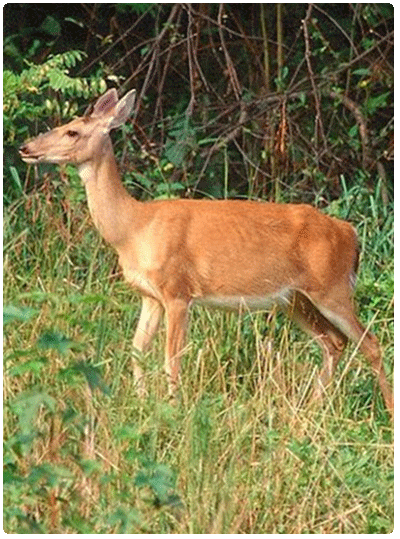To date, Chronic Wasting Disease has not been detected in any deer populations within Vermont.
What is Chronic Wasting Disease (CWD)?
 Chronic wasting disease (CWD) is a fatal neurological (brain and nervous system) disease found in deer, elk, caribou, and moose (cervids) populations in certain geographical locations in North America. CWD is caused by a mutant protein, called a prion.
Chronic wasting disease (CWD) is a fatal neurological (brain and nervous system) disease found in deer, elk, caribou, and moose (cervids) populations in certain geographical locations in North America. CWD is caused by a mutant protein, called a prion.
The disease belongs to a family of diseases known as transmissible spongiform encephalopathies (TSE) or prion diseases. The disease attacks the brains of the infected animal and produces small lesions that result in death. While CWD is similar to mad cow disease in cattle and scrapie in sheep, there is no known relationship between CWD and any other TSE of animals or people.
Where has CWD Been Found?
The following states and Canadian provinces have found CWD in their deer or elk populations:
Alabama, Arkansas, California, Colorado, Florida, Idaho, Illinois, Indiana, Iowa, Kansas, Kentucky, Louisiana, Maryland, Michigan, Minnesota, Mississippi, Missouri, Montana, Nebraska, New Mexico, New York, North Carolina, North Dakota, Ohio, Oklahoma, Pennsylvania, South Dakota, Tennessee, Texas, Utah, Virginia, Washington, West Virginia, Wisconsin, Wyoming, Alberta, British Columbia, Manitoba, Quebec, and Saskatchewan.
Does CWD Pose a Risk to People?
There currently is no convincing evidence that the agent of CWD affects humans. However, public health officials recommend that human exposure to the CWD agent be avoided as they continue to research the disease.
What Should Hunters Know?
Vermont has two important regulations designed to help prevent CWD from entering the state. First, it is illegal to import and possess carcasses of deer or elk, or parts of deer or elk, legally harvested from states and Canadian provinces that have had Chronic Wasting Disease. Visit Big Game Taken Outside of Vermont for more information.
Second, it is illegal to possess and use urine-based deer lures when hunting deer in Vermont. This prohibition is designed to eliminate the chance of infected urine from commercial captive white-tailed herds being placed into Vermont soils.
Health officials advise hunter not to consume meat from animals known to be infected with the disease. Boning out meat is recommended. In addition, they suggest hunters take the normal simple precautions when field dressing carcasses.
Check out Recommendations for Hunters: Simple Precautions for more information.
How is CWD Transmitted?
CWD is spread by close contact between animals. Animals exposed to a CWD-contaminated environment also may become infected. Research shows prions can be shed in saliva, blood, urine, feces, antler velvet, and body fat. Prions bind to soil where they can remain infectious for years.
What are the Signs of CWD?
Usually, months to years pass before an infected animal shows signs of the disease, even when an infected deer or moose is contagious. Classic signs of CWD in animals aged 18 months or older, include emaciation, drooping head and ears, listlessness, teeth grinding, increased salivation, and excessive thirst and urination. CWD is always fatal to infected cervids.
How is CWD Diagnosed?
There has been no way to test a live animal for CWD. Scientists must microscopically examine the brain from a recently dead animal to detect credible signs of the disease. Researchers have tried to develop a live-animal test using tonsil biopsies and rectal swabs, but live-tests remain unreliable.
